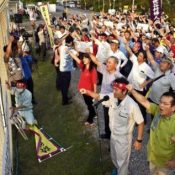
May 12, 2017 Ryukyu Shimpo
From 6 p.m. on May 11, a protest titled “5.11 Village Convention Opposed to Repeated Hanging Training by the U.S. Helicopter” was held at the Toguchi Gate of U.S. Army Torii Station. The convention called for discontinuation of training involving vehicles being hung from U.S. military helicopters, which was carried out twice this year. 300 people including villagers participated and protested.
Mayor Ishimine, who served as a chairman of the convention criticized the military saying, “[The training] disrespects our prefectural people who continue to raise their voices in protest. It cannot be tolerated.” The U.S. military carried out the hanging drill at the Torii communication facility on March 15. The village assembly passed a protest resolution and opinion against the U.S. military and the Okinawa Defense Bureau; however, the training was carried out again on April 19.
(English translation by T&CT and Megumi Chibana)
Go to Japanese
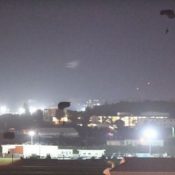
May 10, 2017 Ryukyu Shimpo
The U.S. military conducted drop training using parachutes around 7:30 p.m. on May 10 at Kadena Air Base. According to town officials, this is the first parachute drop training to be conducted at night since the Japan-US Special Action Committee on Okinawa was announced. Parachute training was also carried out on April 24, the first time since 2011. A group consisting of Kadena Town, Okinawa City, and Chatan Town has protested against the training, and it is expected to further fuel resentment from the surrounding residents.
The training was carried out a total of three times, in which approximately ten soldiers dropped from MC 130 special aircraft at about 2000-meters altitude. A couple of soldiers dropped every 15 minutes using parachutes to land on the green area between runways on the base. There were no materials dropped.
Both the US and Japanese governments agreed to relocate operations of the parachute training from Yomitan sub airfield to Iejima sub airfield during the SACO in 1996.
(English translation by T&CT and Sayaka Sakuma)
Go to Japanese
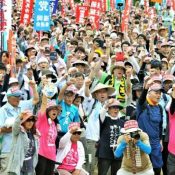
May 15, 2017 Ryukyu Shimpo
On May 15, Okinawa reached the milestone of 45 years of reversion to Japan from U.S. occupation.
Okinawans have aspired to make their islands free of military bases, but have still not realized their dream.
The Japanese government is forcibly constructing a new base in Henoko, Nago, as a part of the relocation of U.S. Marine Corps Air Station Futenma in Ginowan.
On May 14, the day before marking the 45th anniversary of reversion, on the beach of Sedake, Nago, from where protesters can see the construction site, the 5.1 Peace March Execution Committee and the Okinawa Peace Movement Center held a rally.
According to the organizers, about 2,200 people took part, holding up their fists in protest against the construction of the new base.
Hiroji Yamashiro, chairperson of the Okinawa Peace Movement Center said, “We will not lose, we will not allow any bases to be built anywhere in the prefecture and will block the path to war. We will scrum with the people of Miyako and Yaeyama Islands.”
Nago Mayor Susumu Inamine said, “We must start the struggle to take back democracy and local autonomy of Okinawa and Japan, just now on Sedake Beach. I will hold on to my belief in not allowing the government to build the new base in the sea of Henoko.”
The rally participants adopted a declaration expressing strong opposition to the strengthening and expansion of the U.S. military and Japanese Self-Defence Forces (SDF)’ bases promoted by the governments of Japan and the United States. It referred to the SDF’s unit deployment to Miyako and Yaeyama.
Participants marched about two kilometers to the Wansaka Oura Park and repeated “Gambaro!” three times at the end.
(English translation by T&CT)
Go to Japanese
April 29, 2017 Ryukyu Shimpo
At the 16th session of the United Nations Permanent Forum on Indigenous Issues (UNPFII) being held at the United Nations headquarters, a representative for the Asia region prepared a statement indicating that the construction of a new base in Okinawa is being pushed forward without the acceptance of Okinawans. This shows that understanding of Okinawa’s base problems is making headway within the United Nations.
The statement has great significance in shaking the Japanese government, which continues taking high-handed measures and ignoring the will of Okinawans. We should continue working to address the international community, thereby increasing empathy with Okinawa.
At an NGO-sponsored event, Okinawa International University professor and forum attendee Masaki Tomochi announced that forceful measures are being used to proceed with construction in Henoko, Nago. It is encouraging that in response to Dr. Tomochi’s criticism of the Japanese and U.S. governments and strong call for a stop to the construction, participants from Asia and South America made comments indicating that they shared his sense of crisis.
Okinawans have expressed opposition to the construction of a new base and the deployment of Osprey aircraft in elections and large-scale demonstrations and by many other methods. However, the Japanese governments continues to push forward forcefully, trampling on the will of Okinawans and using police force to suppress actions of dissent which are a manifestation of freedom of speech and expression. People such as Dr. Tomochi are taking the issue to the UN as part of efforts to overcome this situation.
The aforementioned statement also criticized the fact that despite numerous recommendations by the UN, the Japanese government still does not recognize Okinawans as an indigenous people.
An indigenous people refers to a group of people who originally lived on certain land. The discussion on Okinawans as an indigenous people is premised on the fact that people with Okinawan roots hold such an identity. In view of the history in which Okinawa was annexed by Japan and subjected to assimilation measures, it is natural for Okinawans to assert their right to self-determination as an indigenous people.
According to Dr. Tomochi, a Japanese government representative responded to the statement by saying, “trespassing into restricted areas and other illegal forms or protest are being carried out.” When Governor Takeshi Onaga stated at the UN in 2015 that Okinawa’s right to self-determination is being neglected, the Japanese government stated that Japan’s national security is its top priority and that the Henoko construction plan is proceeding in a lawful manner.
In a space for discussing the violation of Okinawa’s right to self-determination, the Japanese government can do no more than make these kinds of irrelevant assertions, and is thus losing the trust of the international community. The Japanese government should recognize that unless it immediately stops its discriminatory policies toward Okinawa and respects Okinawa’s will and right to self-determination, it will never regain that trust.
(English translation by T&CT and Sandi Aritza)
Go To Japanase
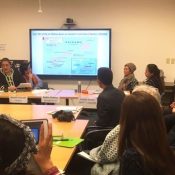
April 27, 2017 Ryukyu Shimpo
Washington Special Correspondent Yukiyo Zaha reporting
On the morning on April 25 (local time), the 16th session of the UN Permanent Forum on Indigenous Issues that convened at the United Nations Headquarters in New York held a meeting between the UN General Assembly and indigenous peoples representatives from around the world. A delegate from Asia included in his speech a statement about Okinawa. He said that despite repeated recommendations from the UN, the Government of Japan does not recognize Okinawans as indigenous people. This representative went on to say that the Japanese government, without understanding Okinawans, is forcing through construction of a new base in Henoko, Nago City.
According to Okinawa International University Professor Masaki Tomochi, who attended the meeting, a Japanese government representative said that, “Although the Constitution of Japan allows freedom of expression, illegal protest activities such as entering restricted areas are being conducted.” Tomochi pointed out that the statement was intended to downplay the legitimacy of the anti-base movement.
In the evening the NGO Asia Indigenous Peoples Pact (AIPP), the mission of which is to address issues faced by indigenous people throughout Asia, hosted an event. At the event Professor Tomochi reported that the Government of Japan has started embankment work for the new base in Henoko. He is highly critical of the US and Japanese governments’ handling of the situation, and emphatically calls for construction to be stopped immediately, but moreover for it to be stopped and not to be resumed.
During the event, delegates from around Asia and a South American support group that tackles indigenous people’s issues made a declaration expressing their sense of impending danger for Okinawa. The declaration imparted that the lives and peace of indigenous people are exposed to dangers through Okinawan land being developed into military bases.
(English translation by T&CT and Erin Jones)
Go To Japanese
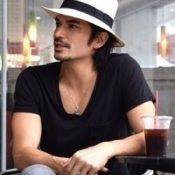
May 10, 2017 Ryukyu Shimpo
By Hiroko Sato
“’We want to send a message to the world from Okinawa.’ The movie was created by a group with this mindset.”
Okinawan-born actor Shogen’s face may have imposing, lofty features, but in an instant it can change into a warm smile. The 38 year-old actor is based in Tokyo, and has a career that reaches far and wide, appearing in movies and dramas both in Japan and abroad.
When he begins talking about the feature-length film “Kokoro, Odoru,” (Directed by Tsukasa Kishimoto), which was shot on Zamami Island, he visibly lights up.
We talked about the must-see film he “poured everything possible into,” his thoughts on Okinawa, and his future ambitions.
The underlying theme for Omnibus Vol. 3 is “parents and children”
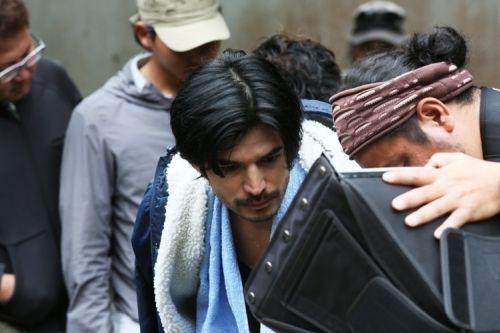
In the movie “Kokoro, Odoru,” you play the main character, Yuhi. In the role, you are the son of Hana Hanashiro, played by Taeko Yoshida. What is Yuhi like?
He is an upstanding guy, and terrified of any wrongdoing. He is also very moody, and sometimes makes others angry. However, I think he can also be goofy at times, and loves mischief. I think he resembles myself to an extent. So, there is a good amount of myself in the performance.
This is an expansion of the short film “Kokoro, Odoru Kerama Blue” shot in 2015. Were you mindful of this when filming?
The short film was about 30 minutes in in length, and it was very fast-paced with strong comedic elements. For the feature-length film, we were able to dig into Yuhi’s background more. During the short film, I felt that Yuhi’s family environment was one where he grew up without his parents, and this fueled the character creation for the longer film as well.
That connects to the theme of the movie, right?
The movie is an omnibus of 3 intersecting episodes, and the theme running through all three parts is “parents and children.” A husband and wife bringing new life into the world, parents who have become estranged from their child, and a parent-child relationship with no blood connection… the movie depicts a variety of familial relationships.
For example, the second story is an episode where Yuhi’s childhood friend leaves behind their son to go the “mainland,” however in the end they return to the island to re-start their life for the sake of their child. However, Yuhi himself was raised by his grandmother. I wonder how Yuhi feels about his childhood friend…
In a way, I feel the movie we made has the audience following Yuhi, and has them thinking “What if I were him,” as he meets with the different characters in the movie.
Nevertheless, since the director, Kishimoto, wrote an outstanding script filled with humor, I gave a lot of importance to that worldview.
Including the short film, this is your second time filming on Zamami Island. What impression did the island leave on you?
The island was a lot more welcome than the last time (laughs). I think they really cared about the short film, which made me very happy. So, we progressed with shooting with many thanks to the people of the island.
Actually, the director is a rain bringer (laughs)! For over two weeks of shooting, we had terrible weather, and it was even a downpour when we needed sunny weather the most. It made us follow a very strange shooting schedule.
What did you like about Zamami?
Since I had to concentrate during shooting, I wasn’t very aware of my surroundings, however on a day off I went jogging by myself around the island. Being in the middle of nature, the color of the ocean of course, and the color and fragrance of the trees and grass made me think, “Ah, I’m glad I came to Zamami.”
The identity is “Okinawa”
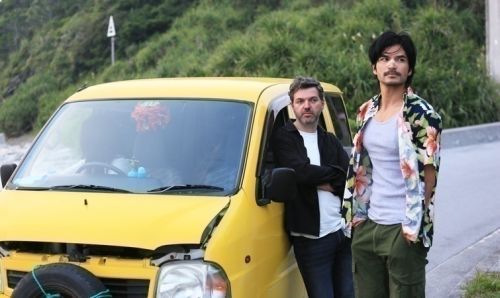
Changing topics, starting with an active modeling career in Paris and London, you have studied acting in New York, and recently appeared in a television drama in Malaysia, meaning your career has ranged far and wide from its base in Tokyo. How have you held on to your Okinawan roots?
Whenever I am asked where I am from when working abroad, I answer “Okinawa.” Of course, while Okinawa is part of Japan, in my heart I strongly identify as Okinawan first, and Japanese second. I still meet people who do not know Okinawa, and I take that chance to tell them how marvelous it is.
Okinawa, of course, has a fabulous ocean and natural environment, but it also has a unique culture that has been passed down from the Ryukyu-Kingdom era. When I talk with young actors from mainland Japan, there are still many who do not even know that until Okinawa was handed back to Japan from America in 1972, Okinawa used the U.S. dollar. It makes me think that I’m getting old (laughs).
What is different with working in Okinawa from working in Tokyo or abroad?
The smell is different. This is where I grew up until I was 18. The smell of the ocean, the smell of foliage after rain… Since it connects me to the memories of my youth, I not only feel nostalgic, but it brings up a lot of different emotions.
I want to show Okinawa to the world
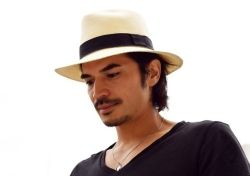
What kind of a movie is “Kokoro, Odoru” to you?
With the unity of an Okinawan director, Okinawan producer, and Okinawan staff, this movie was made with a lot of love. I also helped in creating the script. Truly, we poured everything we possibly could into this Okinawa-made movie.
Tell me about your goals and ambitions from now.
It has been true up until now, but when I leave Okinawa it is the same whether I am in Japan or abroad. The only difference for me is whether I am “on the island” or “off the island.” As long as I am needed, I want to put all my efforts into acting.
Through “Kokoro, Odoru,” I was able to meet many people who want to show Okinawa to the world. Right now I am based in Tokyo, however I am looking for ways to showcase Okinawa. I think it would be good for Okinawa to branch out into Asia. Recently there have been a lot more opportunities for collaboration with Southeast Asia. This is because one of my strongpoints is acting in English.
In particular, I want as many people as possible to see “Kokoro, Odoru.”
Shogen and director Tsukasa Kishimoto wrapped the filming in March, and as of May are in the final stages of editing. After debuting in film festivals, they are looking to release the movie in Okinawa in summer, 2018.
In order to screen the movie in Okinawa, followed by screenings throughout Japan, the movie makers are calling for support to host a premier in Okinawa using the YUIMA crowdfunding platform (https://yuima-okinawa.jp/) for details click here.
Shogen’s Profile
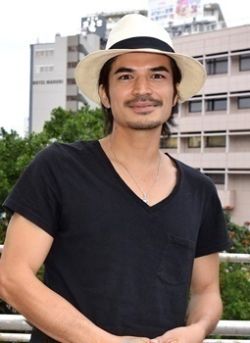
After graduating university, Shogen backpacked through over 40 countries while modeling in Paris, Milan, and London. In 2004, he returned to Japan and started acting at age 25.
In 2005, he debuted in the film “Habu to genkotsu” which depicted post-war Okinawa. He played the main character, a sanshin player, and was nominated at the 20th Tokyo International Film festival. He continued to mainly work in film, but in 2008 met a method actor, and the strong impression made on him led him to decide to study acting in New York, and traveled there the following year. There, he studied under teachers such as Nicole Kidman’s private coaches Susan Batson and Roberta Wallch. In 2010 he was selected to CNN’s “Tokyo Hot List: 20 people to watch in 2010,” after appearing in a “Seven Samurai” remake and a JT Sven Stars advertisement, which got rave reviews.
(English translation by T&CT and Sam Grieb)
Go To Japanese
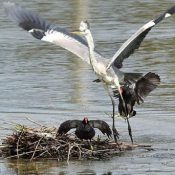
May 10, 2017 Ryukyu Shimpo
Bird Week began on May 10. Many wild birds can be seen resting by the “Triangle Pond” in Yone, Tomigusuku City. On May 8, bystanders witnessed a pair of waterhens drive back a grey heron for approaching their nest. Also on May 8 at Ryutan located in Shurimawashi Town, Naha City, a family of Muscovy ducks were seen taking a stroll and looking comfortable under the warm sun.
(English translation by T&CT and Chelsea Ashimine)
Go To Japanese
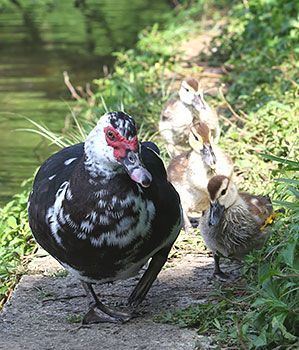
A family of Muscovy ducks on a stroll under the warm sun, taken on the afternoon of May 8 at Ryutan of Shurimawashi Town, Naha City.
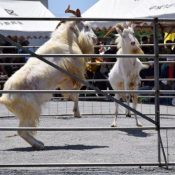
May 4, 2017 Ryukyu Shimpo
On May 4, at the Nakata Shokai in Sesoko, Motobu, goat fighting, or pijaorasai was held. Approximately 500 people from the town and visitors gathered and watched goat-fighting as they enjoyed goat sashimi and goat soup.
Twenty goats from Motobu Town and Nago City participated. Raising both forelimbs, the goats fought in a dynamic way as they lowered their bodies and hit their horns against their opponents. Some made friends with their opponent and others ran away from the fight. The venue was full of laughter as spectators enjoyed the unique goat “battle.”
Eighty-one year-old Tetsuo Mukai from Naha said, “I look forward to pijaorasai every year. Goat soup and sashimi are the best here.”
(English translation by T&CT and Megumi Chibana)
Go to Japanese
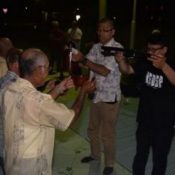
May 6, 2017 Ryukyu Shimpo
Tarama Island’s traditional event “Stuupunaka festival” was held on May 5 and 6, with locals gathering to give thanks for the year of good harvest and pray for community prosperity.
The dawn prayer began from the night of May 5, when elders sang the sacred song (Niri) and exchanged sake.
After the elders sang, the young men raised square bowls filled with sake above their heads and jeered, saying, “Heya, Yakkayakka”.
The voices resounded in a quiet evening with an early summer breeze.
Stuupunaka is one of the two major events of Tarama Village, along with “Patchugatsu-ugan”(August Dancing), which is one of the nation’s designated significant intangible folklore cultural assets.
The event is held at the four festival venues in the village. Legend has it the villagers held the event to calm the wrath of the dragon god of the undersea palace Ryugu, and to offer thanks.
(English translation by T&CT)
Go to Japanese
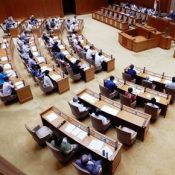
May 3, 2017 Ryukyu Shimpo
The Okinawa Prefectural Assembly held an extraordinary plenary session on May 2, and unanimously passed a protest resolution and an opinion letter asking for an investigation into the cause of the alleged stray bullet incident and prevention of a recurrence. At the Afuso Dam construction site in the U.S. military’s Camp Hansen, Onna Village, a bullet-like object, which hit and damaged a construction vehicle and a water tank, was recently found.
In addition, the assembly unanimously adopted a protest resolution and an opinion letter regarding the parachute drop training conducted at Kadena Air Base on April 24.
The resolution and opinion letter regarding the suspected stray bullet asked for a thorough investigation of the relationship between the training and the accident, prompt announcement of the results and suspension of the training until the recurrence prevention measures are carried out, noting that “it gave great disturbance and fear to the citizens who are forced to live with danger because even the slightest mistake will result in a disaster involving human life.”
The assembly made five requests, including a revision of the Japan-U.S. Status of Forces Agreement (SOFA) in order to allow local municipalities’ staff and the prefectural police officers to enter the U.S. military facilities and conduct a quick investigation, and detailed prior notification of exercise and training.
The resolution and opinion letter regarding the parachute drop training requested that the training not be conducted in the future, claiming, “it is absolutely dangerous training that might have caused serious accidents involving residents. This is not tolerable and it is nothing but an increase of the burden of the base on the people.”
The resolutions and opinion papers will be sent to U.S. ambassadors to Japan and the commander of all U.S. forces in Japan, the Prime Minister, the Foreign Affairs Minister and the Defense Minister.
(English translation by T&CT)
Go to Japanese

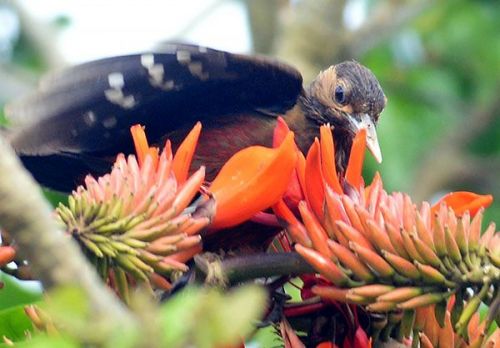













 Webcam(Kokusai Street)
Webcam(Kokusai Street)


